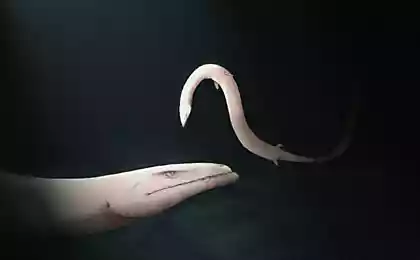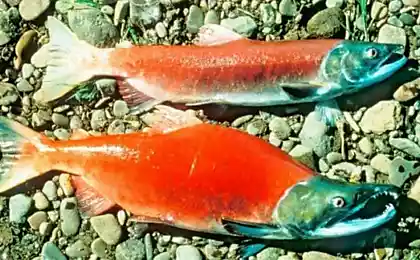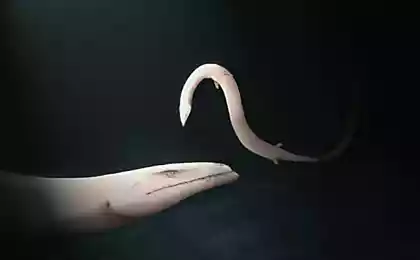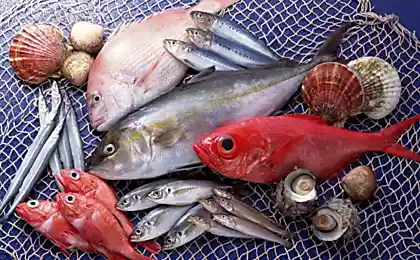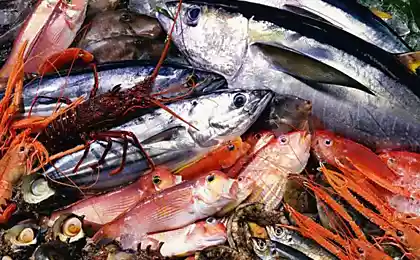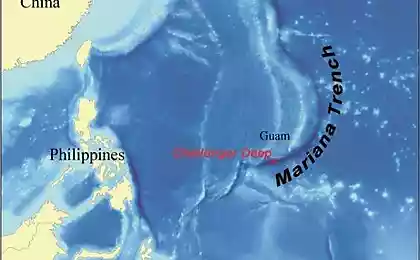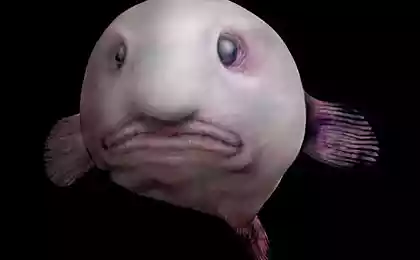6790
Rare fish in the deep sea (10 photos)
In the middle of the last century began to actively explore the underwater world. At the bottom of the oceans live millions of different species, many of which are still not known to us.
Look at a selection of rare fish, which turned out to discover humanity.
Also see:
The inhabitants of the underwater world (51 photos)
Underwater Zoo amazing creatures in Indonesia (28 photos)
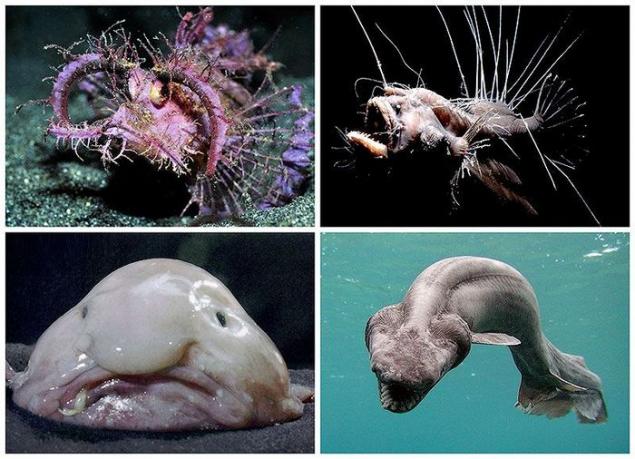
1. Ambon scorpionfish (Eng. Ambon Scorpionfish, lat. Pteroidichthys amboinensis).

Opened in 1856. Easily identifiable by the huge "eyebrows" - specific build-up over the eyes. Is able to change color and fade. Leads "guerrilla" hunt - masquerading on the bottom and waiting for prey. Is not uncommon and quite well studied, but its extravagant appearance simply can not fail to note! (Roger Steene / Conservation International)
2. psychedelic fish-frog (Eng. Psychedelic Frogfish, lat. Histiophryne psychedelica).
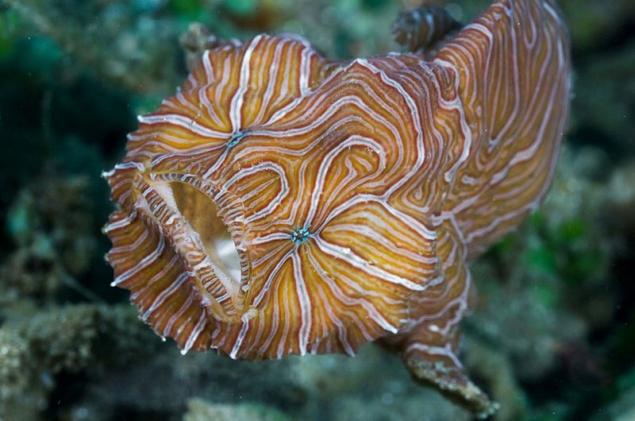
Opened in 2009. Very unusual fish - tail fin is bent to one side, modified pectoral fins like legs and land animals. The head is large, wide-set eyes directed forward, as in vertebrates, so the fish has a kind of "face." Color yellow or reddish fish with winding blue and white stripes, radiating in all directions from the eyes of blue. Unlike other fish that swim, this kind of like jumping moves, starting from the bottom of the pectoral fins and pushing water from the gill slits, creating reactive thrust. Fish tail curved to one side and can not directly guide the body, because it varies from side to side. Also fish can crawl along the bottom with the help of the pectoral fins, turning them both down. (David Hall / EOL Rapid Response Team)
3. rag-pickers (Eng. Leafy Seadragon, lat. Phycodurus eques).
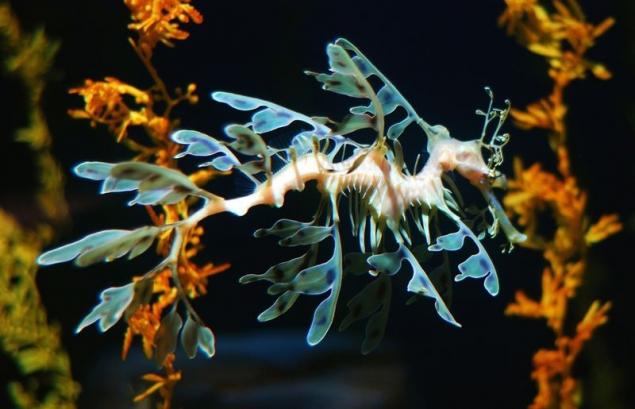
Opened in 1865. The representatives of this species are remarkable that all their body and head covered with spikes, simulating thallus algae. Although these processes and are similar to the fins at sea, they do not take part, serve to mask (as in the hunt for shrimp and for protection from enemies). Inhabits the waters of the Indian Ocean surrounding the southern, south-eastern and south-western Australia, as well as northern and eastern Tasmania. It feeds on plankton, small shrimp, algae. Lacking teeth picker swallow food whole. (Lecates / Flickr)
4. Ocean sunfish (Eng. Ocean Sunfish, lat. Mola mola).
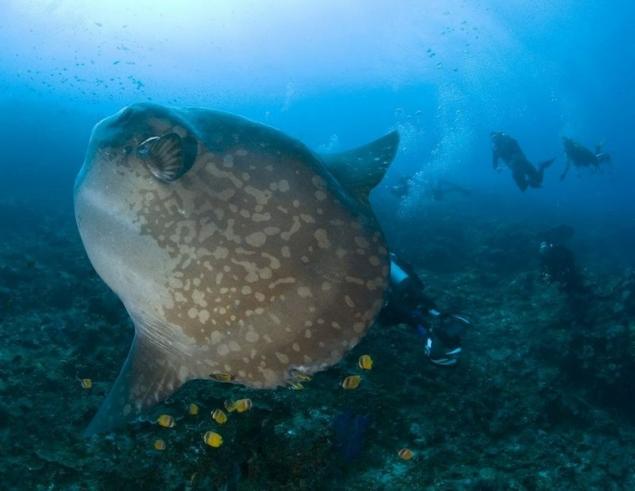
Opened in 1758. Laterally compressed body is extremely tall and short, which gives the fish very strange form it resembles the shape of a disc. The tail is very short, broad and truncated; dorsal, caudal fins and rear are interconnected. Fish skin-moon thick and elastic, covered with small bony tubercles. You can often see the moon-fish lying on its side on the surface of the water. Adult amusement fish - very bad swimmer, unable to overcome a strong current. It feeds on plankton, and squid, eel larvae, salps, ctenophores and jellyfish. Can reach huge sizes of a few tens of meters and weighing 1, 5 tons. (Franco Banfi)
5. chimera of New World (Eng. Broadnose chimaera, lat. Rhinochimaera atlantica).
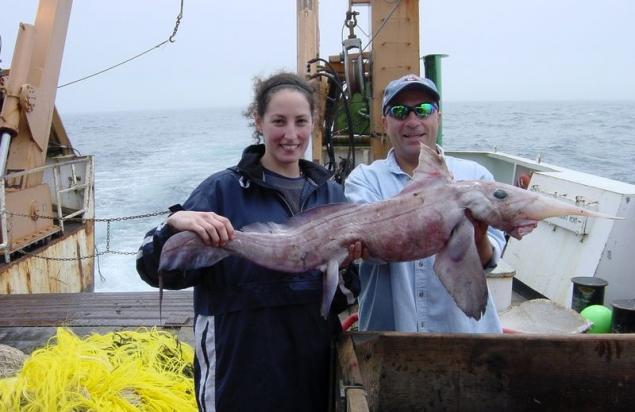
Opened in 1909. Absolutely disgusting-looking jelly fish. Lives at the bottom of the deep Atlantic Ocean and feeds on shellfish. Studied very poorly. (Jay Burnett, NOAA / NMFS / NEFSC)
6. Plaschenosets (Eng. Frilled Shark, lat. Chlamydoselachus anguineus).
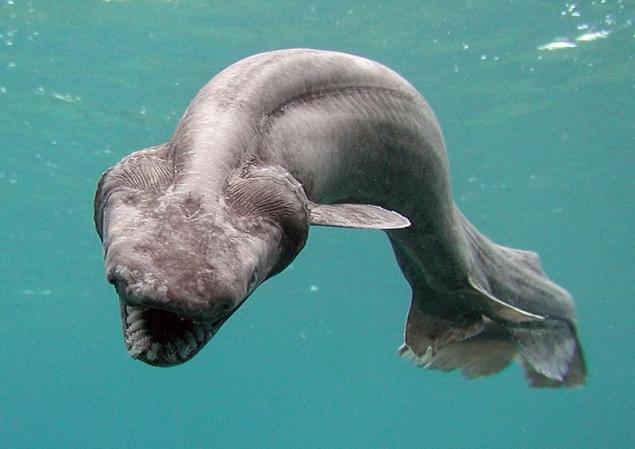
Opened in 1884. These sharks are apparently much more like a strange sea snake or eel than their closest relatives. In Chlamydoselachus gill openings, of which there are six on each side, covered with skin folds. In this case, the membrane first gill slit the throat of fish and cross are interconnected, forming a broad blade skin. Along with the Goblin shark is one of the rarest sharks on the planet. We know no more than a hundred copies of these fish. They studied very poorly. (Awashima Marine Park / Getty Images)
7. Indonesian Coelacanth (Eng. Indonesian Coelacanth, lat. Latimeria menadoensis).
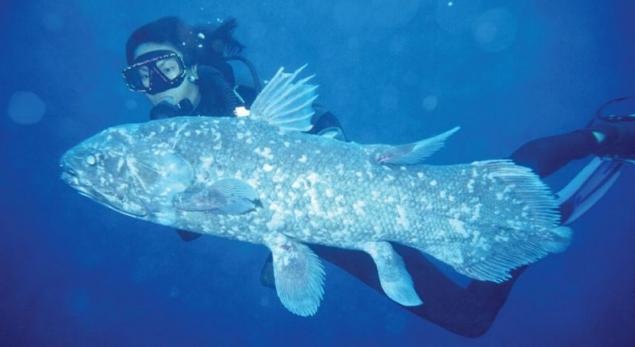
Opened in 1999. Living fossil and is probably the oldest fish in the world. Prior to the opening of the first members of the order tselikantov, which include coelacanth, he was considered completely extinct. Time of divergence of the two species of modern coelacanth is 30-40 million years old. On live video caught no more than ten. (Pearson - Benjamin Cummings)
8. Tons angler (Eng. Hairy Angler, lat. Caulophryne polynema).
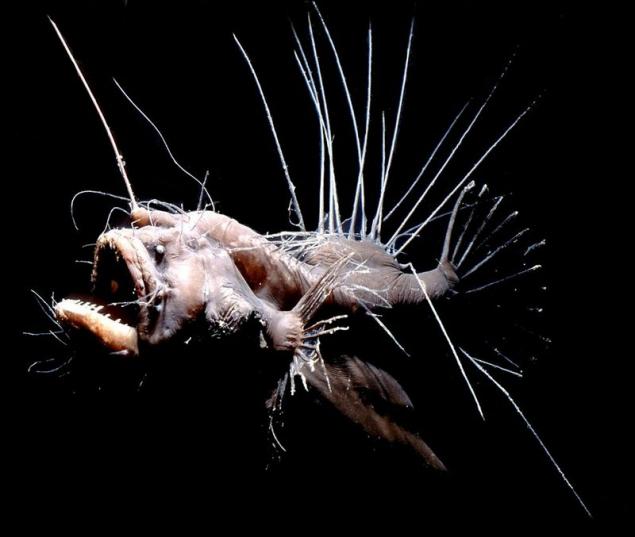
Opened in 1930. Very strange and scary fish that live on the bottom of the deep, where there is no sunlight - 1 km and deeper. To lure the inhabitants of the deep sea uses a special glowing lump on the forehead, around the characteristic detachment Anglerfish. Due to the special metabolism and very sharp teeth, he can have everything that comes, even if the victim several times more and also a predator. Propagated by no less strange than it looks and eats - because of unusually harsh conditions and scarcity of fish, male (ten times less than for the female) is attached to the flesh of his chosen and passes all necessary through the blood. (BBC)
9. Fish-drop (Eng. Blobfish, lat. Psychrolutes marcidus).
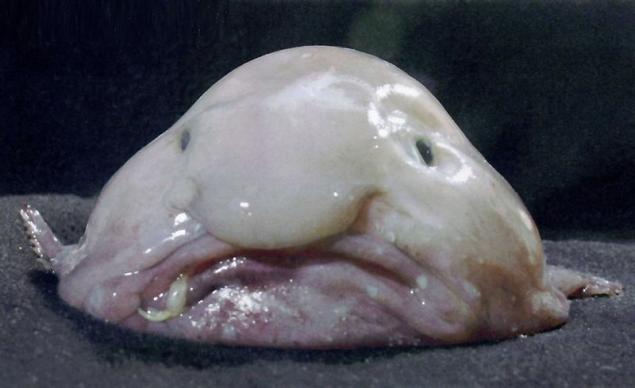
Opened in 1926. Often mistaken for a joke. In fact, it is quite real kind of deep-sea benthic marine fish of the family psihrolyutovyh, which on the surface become "jelly" look to "a sad expression." Poorly understood, but it's enough to recognize it as one of the most bizarre. In the photo - a copy of the Australian Museum. (Kerryn Parkinson / Australian Museum)
10. Macropinna microstoma (Eng., Lat. Macropinna microstoma) - winner for quirkiness.
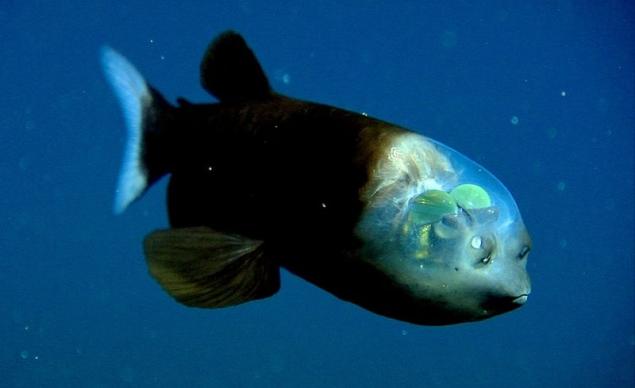
Opened in 1939. Lives at very great depths, so little studied. In particular, it is not clear was the principle of the fish. It was believed that she must be very great difficulties due to the fact that she only sees up. Only in 2009 was fully investigated the structure of the eye of the fish. Apparently, when trying to study it before the fish just could not stand the pressure change. The most notable feature of this type is a transparent dome-shaped shell that covers her head on the top and on the sides, and a large, usually upward, eyes cylindrical shape that are under this shell. Dense and elastic covering shell is attached to the back of the scales of the back and on the sides - a wide and transparent periocular bones that protect your eyes. This coating structure is normally lost (or at least greatly damaged) when the rise of fishes on the surface of the trawl nets and so on until the last time its existence has not been known. By covering the shell is filled with a clear liquid chamber in which, in fact, are the eyes of a fish; eyes from living fish painted in bright green and separated by a thin bony septum, which, extending back, expands and holds the brain. In front of each eye, but behind the mouth, there is a large round pocket that contains olfactory receptor socket. That is something that at first glance the photos of live fish seem eyes, is actually olfactory organ. The green color is caused by the presence of a specific yellow pigment. It is believed that this pigment provides a special filtering light coming from above, and reduces the brightness that allows the fish to distinguish bioluminescence potential prey. (Monterey Bay Aquarium Research Institute)
Source: bigpicture.ru
Look at a selection of rare fish, which turned out to discover humanity.
Also see:
The inhabitants of the underwater world (51 photos)
Underwater Zoo amazing creatures in Indonesia (28 photos)

1. Ambon scorpionfish (Eng. Ambon Scorpionfish, lat. Pteroidichthys amboinensis).

Opened in 1856. Easily identifiable by the huge "eyebrows" - specific build-up over the eyes. Is able to change color and fade. Leads "guerrilla" hunt - masquerading on the bottom and waiting for prey. Is not uncommon and quite well studied, but its extravagant appearance simply can not fail to note! (Roger Steene / Conservation International)
2. psychedelic fish-frog (Eng. Psychedelic Frogfish, lat. Histiophryne psychedelica).

Opened in 2009. Very unusual fish - tail fin is bent to one side, modified pectoral fins like legs and land animals. The head is large, wide-set eyes directed forward, as in vertebrates, so the fish has a kind of "face." Color yellow or reddish fish with winding blue and white stripes, radiating in all directions from the eyes of blue. Unlike other fish that swim, this kind of like jumping moves, starting from the bottom of the pectoral fins and pushing water from the gill slits, creating reactive thrust. Fish tail curved to one side and can not directly guide the body, because it varies from side to side. Also fish can crawl along the bottom with the help of the pectoral fins, turning them both down. (David Hall / EOL Rapid Response Team)
3. rag-pickers (Eng. Leafy Seadragon, lat. Phycodurus eques).

Opened in 1865. The representatives of this species are remarkable that all their body and head covered with spikes, simulating thallus algae. Although these processes and are similar to the fins at sea, they do not take part, serve to mask (as in the hunt for shrimp and for protection from enemies). Inhabits the waters of the Indian Ocean surrounding the southern, south-eastern and south-western Australia, as well as northern and eastern Tasmania. It feeds on plankton, small shrimp, algae. Lacking teeth picker swallow food whole. (Lecates / Flickr)
4. Ocean sunfish (Eng. Ocean Sunfish, lat. Mola mola).

Opened in 1758. Laterally compressed body is extremely tall and short, which gives the fish very strange form it resembles the shape of a disc. The tail is very short, broad and truncated; dorsal, caudal fins and rear are interconnected. Fish skin-moon thick and elastic, covered with small bony tubercles. You can often see the moon-fish lying on its side on the surface of the water. Adult amusement fish - very bad swimmer, unable to overcome a strong current. It feeds on plankton, and squid, eel larvae, salps, ctenophores and jellyfish. Can reach huge sizes of a few tens of meters and weighing 1, 5 tons. (Franco Banfi)
5. chimera of New World (Eng. Broadnose chimaera, lat. Rhinochimaera atlantica).

Opened in 1909. Absolutely disgusting-looking jelly fish. Lives at the bottom of the deep Atlantic Ocean and feeds on shellfish. Studied very poorly. (Jay Burnett, NOAA / NMFS / NEFSC)
6. Plaschenosets (Eng. Frilled Shark, lat. Chlamydoselachus anguineus).

Opened in 1884. These sharks are apparently much more like a strange sea snake or eel than their closest relatives. In Chlamydoselachus gill openings, of which there are six on each side, covered with skin folds. In this case, the membrane first gill slit the throat of fish and cross are interconnected, forming a broad blade skin. Along with the Goblin shark is one of the rarest sharks on the planet. We know no more than a hundred copies of these fish. They studied very poorly. (Awashima Marine Park / Getty Images)
7. Indonesian Coelacanth (Eng. Indonesian Coelacanth, lat. Latimeria menadoensis).

Opened in 1999. Living fossil and is probably the oldest fish in the world. Prior to the opening of the first members of the order tselikantov, which include coelacanth, he was considered completely extinct. Time of divergence of the two species of modern coelacanth is 30-40 million years old. On live video caught no more than ten. (Pearson - Benjamin Cummings)
8. Tons angler (Eng. Hairy Angler, lat. Caulophryne polynema).

Opened in 1930. Very strange and scary fish that live on the bottom of the deep, where there is no sunlight - 1 km and deeper. To lure the inhabitants of the deep sea uses a special glowing lump on the forehead, around the characteristic detachment Anglerfish. Due to the special metabolism and very sharp teeth, he can have everything that comes, even if the victim several times more and also a predator. Propagated by no less strange than it looks and eats - because of unusually harsh conditions and scarcity of fish, male (ten times less than for the female) is attached to the flesh of his chosen and passes all necessary through the blood. (BBC)
9. Fish-drop (Eng. Blobfish, lat. Psychrolutes marcidus).

Opened in 1926. Often mistaken for a joke. In fact, it is quite real kind of deep-sea benthic marine fish of the family psihrolyutovyh, which on the surface become "jelly" look to "a sad expression." Poorly understood, but it's enough to recognize it as one of the most bizarre. In the photo - a copy of the Australian Museum. (Kerryn Parkinson / Australian Museum)
10. Macropinna microstoma (Eng., Lat. Macropinna microstoma) - winner for quirkiness.

Opened in 1939. Lives at very great depths, so little studied. In particular, it is not clear was the principle of the fish. It was believed that she must be very great difficulties due to the fact that she only sees up. Only in 2009 was fully investigated the structure of the eye of the fish. Apparently, when trying to study it before the fish just could not stand the pressure change. The most notable feature of this type is a transparent dome-shaped shell that covers her head on the top and on the sides, and a large, usually upward, eyes cylindrical shape that are under this shell. Dense and elastic covering shell is attached to the back of the scales of the back and on the sides - a wide and transparent periocular bones that protect your eyes. This coating structure is normally lost (or at least greatly damaged) when the rise of fishes on the surface of the trawl nets and so on until the last time its existence has not been known. By covering the shell is filled with a clear liquid chamber in which, in fact, are the eyes of a fish; eyes from living fish painted in bright green and separated by a thin bony septum, which, extending back, expands and holds the brain. In front of each eye, but behind the mouth, there is a large round pocket that contains olfactory receptor socket. That is something that at first glance the photos of live fish seem eyes, is actually olfactory organ. The green color is caused by the presence of a specific yellow pigment. It is believed that this pigment provides a special filtering light coming from above, and reduces the brightness that allows the fish to distinguish bioluminescence potential prey. (Monterey Bay Aquarium Research Institute)
Source: bigpicture.ru




